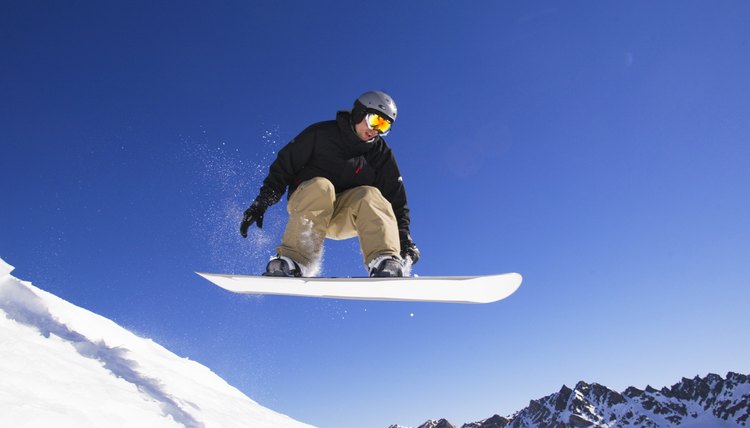Left Leg Is Sore From a Snowboarding Regular Stance

Your left leg is your forward leg when riding with a regular stance. Most problems with sore muscles on the front leg are due to the snowboarder's gear or their riding style. By looking into each of these issues you can determine the source of your leg pain and treat it accordingly.
New Season, New Gear
If you're just starting to snowboard or if it is your first ride of the season, leg soreness is almost impossible to avoid. Snowboarding is incredibly demanding on your legs, so unless you prepared for the season by strength training your legs and performing aerobic conditioning exercises, you're going to be sore after your first few rides. Also, if you bought a new board, boots or bindings this season, they could change the way your legs are positioned on the board and could cause pain and muscle soreness you weren't used to with your old set up.
Binding Angle
Your binding could be putting too much strain on your front foot if you have it at too big or too small of an angle. Tom Buchanan, an instructor and staff trainer at Okemo Mountain Resort, suggests trying a binding angle of 9 degrees on the front binding and minus-9 degrees on the rear. This is a slightly duck stance that helps you center your hips and shoulders on the board. The duck stance also gives your knees a slight, natural bend, which is more relaxing for your legs than a forward or straight stance. If your front binding angle is too big, you will feel strain on your left knee and calf. Adjust your binding to a smaller angle if you feel strain in these areas.
Check Your Boots
Heel lift should be avoided at all cost. Heel lift occurs when your boots are too big or too loose, and your heel slides up and down inside the boot when you turn. Heel lift puts a ton of pressure on your forefoot, which results in toe, forefoot, ankle and lower calf pain. Heel lift can even cause serious injuries due to a lack of control of the board. Make sure your foot fits snugly in your boot, and your ankle doesn't slide up and down when you maneuver your board. If you realize you do have heel lift in a pair of boots you already purchased, ask your local snowboard shop for J-bars to insert between the liner and the boot around your ankle to hold it firmly in place. Custom J-bars can even be made at boot-fitting centers.
Ease the Pain
Stretch your sore muscles immediately after each session while they are still loose and warm. Follow stretching with a light massage if possible. More importantly, rest your sore muscles after a long snowboard session. If your leg is sore after a full day on the mountain, don't go back out for the night session. A sore muscle can result in a worse injury if it is not given proper time to rest. When you're on a snowboard trip, you want to be able to snowboard every day, so elevate your sore leg at night to let it recover for the next day.
References
Writer Bio
Courtney McCaffrey graduated from the College of Charleston in 2008 with a B.A. in media studies. She has served as an editor for Blooming Twig Books and the MADA Writing Services publishing company. She is now a writer on various outdoor sports such as snowboarding, skiing, surfing and bodysurfing.
